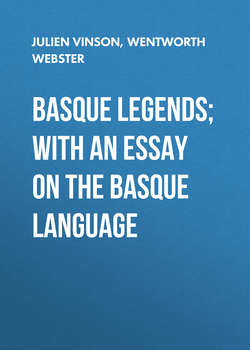Basque Legends; With an Essay on the Basque Language

Реклама. ООО «ЛитРес», ИНН: 7719571260.
Оглавление
Wentworth Webster. Basque Legends; With an Essay on the Basque Language
Introduction
I.—Legends of the Tartaro
The Tartaro
M. d’Abbadie’s Version
Errua, the Madman
Variations of Errua
The Three Brothers, the Cruel Master, and the Tartaro
The Tartaro and Petit Perroquet
II—The Heren-Suge.—The Seven-Headed Serpent
The Grateful Tartaro and the Heren-Suge
The Seven-Headed Serpent
The Serpent in the Wood
III.—Animal Tales
Acheria, the Fox
The Ass and the Wolf
IV.—Basa-Jaun, Basa-Andre, and Lamiñak
Basa-Jauna, the Wild Man
The Servant at the Fairy’s
The Fairy in the House
The Pretty but Idle Girl.54
The Devil’s Age
The Fairy-Queen Godmother.57
V.—Witchcraft and Sorcery
The Witches at the Sabbat.63
The Witches and the Idiots
The Witch and the New-Born Infant
The Changeling
VI.—Contes des Fées
(A.)—Tales like the Keltic
(B.)—Contes des Fées, derived directly from the French
VII.—Religious Tales
Fourteen.172
Jesus Christ and the Old Soldier
The Poor Soldier and the Rich Man
The Widow and her Son.173
The Story of the Hair-Cloth Shirt (La Cilice)
The Saintly Orphan Girl
The Slandered and Despised Young Girl
An Essay on the Basque Language,
Basque Poetry
I.—Pastorales
II
Song of Altabiscar
Song of Altabiscar
Little Peter.213
Отрывок из книги
Who, or what is the Tartaro? “Oh! you mean the man with one eye in the middle of his forehead,” is the prompt and universal answer. The Tartaro is the Cyclops, the sun’s round eye, κύκλωψ. But the word Tartaro has apparently nothing to do with this. M. Cerquand, in his “Legendes et Récits Populaires du Pays Basque,” derives the word from Tartare, Tartar, in the same way as the French word Ogre is said to be derived from Hongrois, Ugri. The only objection to this highly probable derivation (made still more probable by a Souletin variation, Moiriak) is the comparatively late date (the 13th century) of the first appearance of the Tartars in Europe.9 It is besides perfectly true that in many tales the Tartaro replaces, and is identical with the giant or ogre; but this does not appear to us to be the original conception of this mythological monster, nor have we ever heard from an unlettered Basque such a description of him. To them he is simply a Cyclops—a huge man, with an eye in the centre of his forehead.
It is an interesting question—Is there any connection between the Basque Tartaro and the Cyclops of the Odyssey and of the classics? First, we must remark that the Cyclops legend is not peculiar either to the Greek and Latin writers, or even to the Aryan nations; e.g., in his communication of the Tartaro legends to the Société des Sciences de Bayonne, M. d’Abaddie relates how he heard the tale told in June, 1843, in Eastern Africa, in Lat. N. 9.2, E. Lon. 34.48, by a man who had never before quitted the country. It is then only the special form of the legend, and not the primary idea, that the Greeks may have borrowed from the Basques. But there is this to observe—that, with both Greeks and Latins, the Cyclops myth is an occidental and not an oriental one, and is more strictly localised than almost any other. This may be accounted for by saying that the sun’s great fiery eye is rather that of the setting than of the rising sun; that the red-hot stake is the ruddy mountain peak, or the tall fir-trunk, seen against the western horizon, and illumined by his descending rays. But in the stories of Theocritus and Ovid, where the sun-myth is not so apparent, the home of the Cyclops is still Sicily. Our first Tartaro legend reads very like a rough outline of Ovid’s story of “Acis and Galatea.” Now, W. Von Humboldt in his “Prüfung der Untersuchung über die Urbewohner Hispaniens vermittelst der Vaskischen Sprache” (Berlin, 1821), in cap. xlv., p. 167, and, again, con. vii., p. 178, arguing on quite different grounds, places Sicily as the most easterly habitation of the Basques within historic times.10 We leave it then to classical scholars to consider whether the Italic races in Magna Græcia and Sicily may not have come in contact with the Basques there, and from them have adopted their special form of the Cyclops legend.
.....
Our lad begins, and he goes on, and on, and on. He meets an old woman, who says to him:
“Where are you going to, lad?”
.....